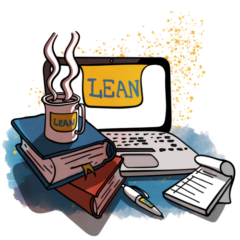-
How it works
How does it work?
Dmaic.com offers comprehensive and fully accredited online Lean training.
Read more Online packagesOnline trainingClassroom trainingsClassroom and in-company training
Online packagesOnline trainingClassroom trainingsClassroom and in-company trainingDmaic.com also offers classroom Lean and Lean Six Sigma training courses Read more
- Pricing
- Companies
- Knowledge
 Knowledge baseWant to know more about Dmaic and what Dmaic means for other companies? Check the Dmaic.com knowledge base.
Knowledge baseWant to know more about Dmaic and what Dmaic means for other companies? Check the Dmaic.com knowledge base. Online WorkshopsDon't immediately choose a course for you: do you want the knowledge and tools with which you can get started right away? Then a Dmaic-workshop is for you.
Online WorkshopsDon't immediately choose a course for you: do you want the knowledge and tools with which you can get started right away? Then a Dmaic-workshop is for you.- About
Mastering Lean Efficiency: Understanding and Eliminating the Eight Wastes (Muda)
Understanding the Concept of Muda (Waste) in Lean
What is Muda?
Muda, a critical term in Lean methodology, refers to activities within a process that consume resources such as time and money but fail to add value for the customer. Recognizing and addressing these activities, classified as Type 2 Muda, is essential in Lean practice. These non-value-adding activities are the primary targets for elimination in the pursuit of efficiency. Waste in Lean manifests in many forms, from the easily observable, like waiting in line, to the more subtle, such as inefficiently utilizing talents.
Muda (waste) describes activities in a process that consume time and money without creating value for the customer. Identifying and eliminating such waste is vital to achieve an efficient and value-driven process.
There are two types of muda:
- Type 1-muda (Business Non-Value Added) includes activities that do not add direct value but are deemed necessary for specific reasons. These forms of waste cannot be immediately eliminated but can potentially be reduced or optimized.
- Type 2-muda comprises activities that do not add value and are considered unnecessary. These wastes are prioritized for elimination, as they directly contribute to inefficiency and increased costs in the process. These constitute the 8 wastes.
While some activities may initially appear valuable, a closer examination based on the three criteria of Value Added often reveals they do not provide real added value. To be considered value-added, an activity must:
- Be something the customer is willing to pay for.
- Transform or change the product or service in a way that aligns with the customer’s specifications.
- Be performed correctly and without errors on the first attempt.
It is crucial to understand that many activities in processes do not add value for the customer. These wastes, often so pervasive and accepted, can render organizations blind to their presence. Recognizing and eliminating such wastes is an essential step in striving for a more efficient and value-driven process.
Taiichi Ohno’s Contribution to Identifying Waste in Lean
Taiichi Ohno, a prominent figure behind Toyota’s Lean manufacturing system, initially identified seven forms of waste. These were later expanded to include an eighth form—Skills or the underutilization of talent, highlighting the importance of fully utilizing workforce capabilities.
The Eight Wastes of Lean Explained
Comprehensive Breakdown of the Eight Wastes:
The concept of ‘waste in Lean’ revolves around eight key areas, commonly referred to as the eight wastes of Lean. Understanding these is crucial for any organization striving for Lean efficiency:
- Transport: The unnecessary movement of products or materials leads to inefficiencies and potential damage or loss.
- Inventory: Excess stock, while sometimes necessary, does not inherently add value and poses financial and space burdens.
- Motion: Wasteful human movements, such as excessive walking or lifting, do not contribute to value creation.
- Waiting: Idle time waiting for materials or approvals is a clear form of waste, representing lost productivity.
- Overproduction: Producing more than customer demand leads to multiple forms of waste, including inventory costs and resource misallocation.
- Overprocessing: Steps in a process that do not add value to the customer are considered wasteful, such as unnecessary features or complexities.
- Defects: Any process step that fails to meet customer specifications requires rework, causing waste and customer dissatisfaction.
- Skills or Underutilized Talent: Not leveraging the full skills and knowledge of employees is a significant waste in Lean methodology.
Remember these wastes with the mnemonic ‘TIMWOODS’: Transport, Inventory, Motion, Waiting, Overproduction, Overprocessing, Defects, Skills.
Strategies for Eliminating Waste in Lean
Tackling Waste Through Process Mapping:
To effectively address waste in Lean, start by visually mapping your process using tools like Makigami diagrams or activity flow diagrams. This allows for a clear identification of where waste occurs within process steps or activities. By recognizing and targeting these eight wastes, organizations can significantly enhance their operational efficiency and customer satisfaction.
A Step-by-Step Guide to Eliminating Waste with Process Mapping:
- Initiate the Process Mapping: Begin your journey towards Lean efficiency by visually mapping your process. Employ tools such as Makigami diagrams or activity flow diagrams. These visual aids provide a clear and comprehensive view of your current processes, allowing you to see every step and identify areas of potential waste.
- Identify Areas of Waste: As you map out your process, focus on pinpointing where the eight wastes occur. These wastes could be in the form of unnecessary movements (motion), waiting times, overproduction, or any other non-value-adding activities. Pay particular attention to steps that do not directly contribute to customer satisfaction or operational efficiency.
- Analyze and Categorize Waste: Once you’ve identified the waste, categorize them into Type 1-muda (necessary but non-value-adding activities) and Type 2-muda (unnecessary and non-value-adding activities). This distinction is crucial for prioritizing your waste reduction efforts.
- Develop Strategies for Waste Reduction: For Type 1-muda, explore ways to streamline these necessary processes to make them more efficient. For Type 2-muda, plan for their complete elimination. Brainstorm with your team to find innovative solutions to reduce or eliminate these wastes.
- Implement Changes and Monitor Results: Begin implementing the changes you’ve identified to reduce waste. Monitor the outcomes of these changes closely. It’s vital to measure the impact of your interventions on process efficiency and customer satisfaction.
- Refine and Iterate: Lean is an ongoing process. Continuously revisit your process maps to identify new areas of waste as your operations evolve. This iterative process ensures ongoing improvement and helps to embed a Lean mindset within your organization.
By following this step-by-step approach, organizations can effectively target and eliminate waste, leading to significantly enhanced operational efficiency and heightened customer satisfaction. Remember, tackling waste in Lean is not a one-time effort but a continuous journey towards process excellence.
Conclusion: The Role of Waste in Lean Philosophy
Understanding and eliminating Muda, the eight wastes, is fundamental in applying Lean principles. By focusing on reducing these wastes, organizations can dramatically improve their efficiency, enhance customer satisfaction, and positively impact their bottom line. Lean is more than a set of tools; it’s a comprehensive philosophy that engages the entire organization in a continuous journey towards operational excellence and improvement.
Become a Lean Expert on Your Schedule: Discover Our Flexible Online Lean Green Belt Training
Ready to finally take a Lean course at your convenience? Look no further! Our online Lean Green Belt training is tailor-made for busy professionals like you. Master the intricacies of Lean methodology at your own pace and from the comfort of your home. Sign up now and take the first step towards becoming a Lean management expert!
Start Your Lean Journey Today!

